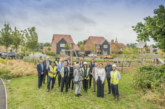
Off-site manufacture means on-site savings, says John Fisher, managing director of the Central Housing Investment Consortium (CHIC), which helps social housing providers to buy better and build more.
In an ideal world, anyone seeking to boost the supply of good quality, affordable housing to meet a long-standing and deep-rooted housing crisis would not start from here. The UK’s chronic shortage of homes is being exacerbated by the extra pressures placed upon social housing providers’ business models from the annual 1% rent cuts, withdrawal of grants and Right to Buy. Thee changes are squeezing income streams and capital resources in ways that make new building a bigger challenge than ever.
It feels like the Government’s (not unreasonable) determination to encourage home ownership has blinded it to the business realities faced by housing associations, councils and arm’s length management organisations (ALMOs).
From a production-process perspective, it’s also crazy that providerss start the design of so many developments from scratch, when we already know what works best. The solution lies in improving efficiency to make sure that every penny of spending really counts. Off-site manufacturing of nw homes (OSM) can help make this happen.
Cheaper, quicker, better
As a procurement consortium that’s involved across every stage of the development, we have embraced OSM as the most viable way of increasing the volume of new-build. Sharing suppliers and purchasing spreads the benefits of scale even further, to smaller developments. As an alternative to traditionally built housing, OSM modular homes can provide better quality, but at lower overall cost and more quickly. And once they’re finished and occupied, most people would not be able to tell the difference. On average, OSM should save 10 to 15% on traditional construction costs.
In a time of tight cost control and changing waether patterns, speed is another big appeal. OSM techniques mean that properties are quickly windproof and watertight, and completed on average withing three to four weeks on site. This makes expenditure much easier to forecast and greatly reduces the scope for unexpected overheads.
Prefabrication does not make designs and developments dull or boring. Some of the OSM projects our consortium has helped procure have featured stunning, curved architecture and been part of bold, new eco-town settlements.
Standardisation saves time and money
Standardised design is the key to generating cashable savings. The more standardised a design is, the cheaper it becomes, because the design cost is divided by the overall number of homes it’s applid to. So taking advantage of standardised house-types enables social housing providers to build more homes or reinvest savings elsewhere.
Too often, organisations specify (for example) a custom built 72m2 house rather than a well-designed, standard 70m2 option that’s ready to build. There is already plenty of variety in modular housing designs, so there’s no need to reinvent the wheel for each scheme.
Working and succeeding together
The more that housing associations, local authorities and ALMOs take up this innovative and practical approach to building, the more they will save and succeed in meeting their objectives to increase housing supply.
Procuring OSM through a consortium like CHIC alsoe helps social housing providers and builders to co-ordinate land supply and construction order books. SO that when the right site comes up at the right price, partners have proven designs and processes to start building straightaway.
CHIC members own and manage 500,000 homes right across England and Wales. Together, we’re bringing the benefits of high-volume, cost-controlled, modern new-build to help solve the housing crisis.








